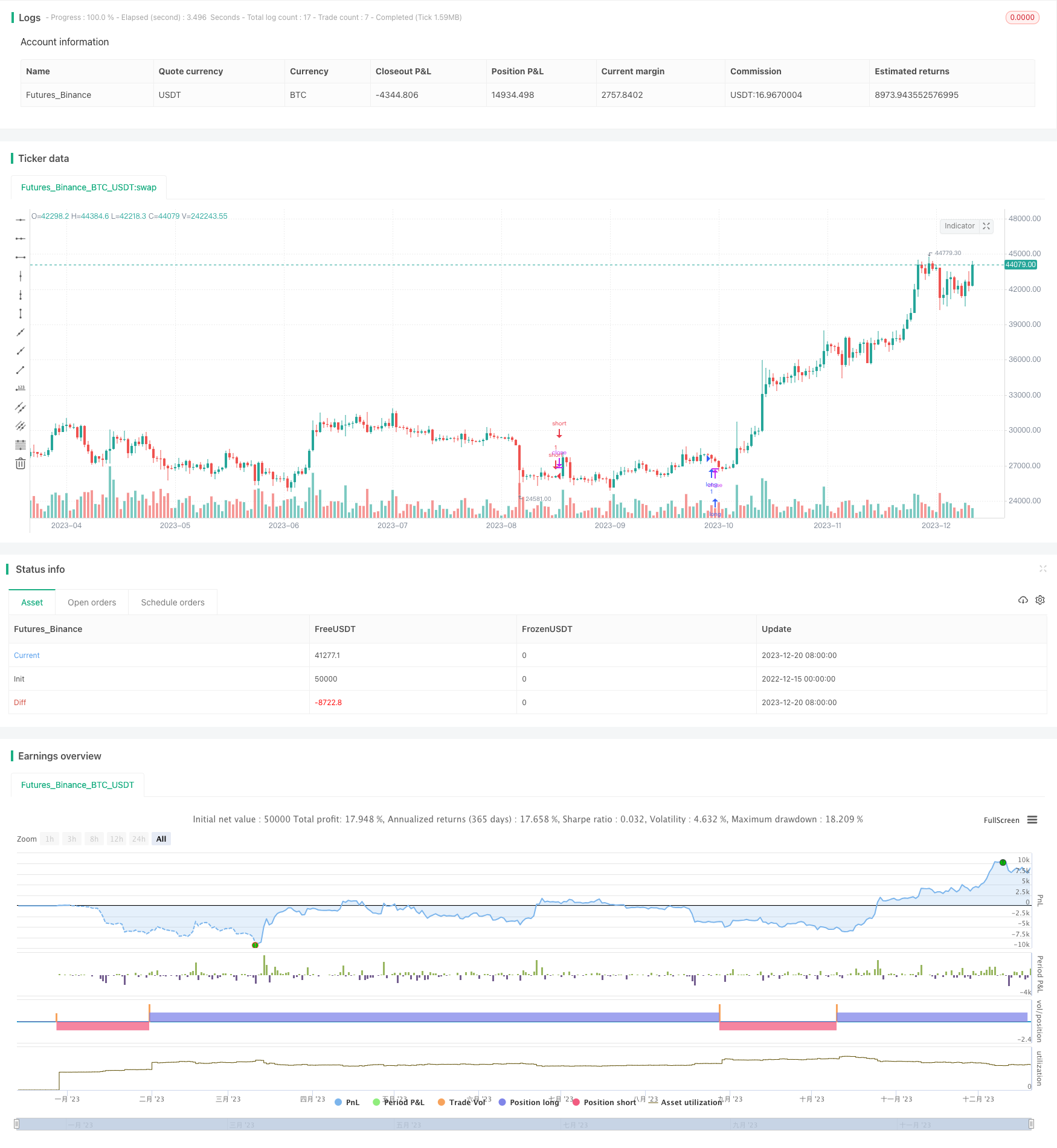Quantitative Trading Price Breakthrough Strategy
Author: ChaoZhang, Date: 2023-12-22 12:42:15Tags:

Overview
This is a short-term quantitative trading strategy based on Simple Moving Average (SMA), Exponential Moving Average (EMA), Keltner Channels, MACD indicator and Stochastic oscillator. It uses the price breakthrough of SMA and EMA, combined with long and short signals from Keltner Channels, MACD and Stochastic to automate trading entries and exits.
Strategy Principle
The strategy uses 25-period SMA, 200-period EMA to build dual moving average lines. When price breaks through the dual moving averages upwards, a buy signal is generated. When price breaks through the dual moving averages downwards, a sell signal is generated.
At the same time, this strategy uses 10-period Keltner Channels. The breakthrough of channel upper and lower bands also serves as assistant signals. The MACD indicator generates trading signals with its fast line, slow line and histogram. The Stochastic oscillator also forms long and short signals with the golden cross and dead cross of its %K line and %D line.
Specifically, when close price is above both SMA and EMA, and within the Keltner Channels, MACD histogram is negative and Stochastic %K is below 50, a long entry signal is triggered. When close price is below both SMA and EMA, and within the Keltner Channels, MACD histogram is positive and Stochastic %K is above 50, a short entry signal is triggered.
Strategy Advantages
- Using dual moving average combined with channel indicator can effectively filter false breakouts.
- Integrating signals from multiple technical indicators can improve reliability.
- Clear long/short rules facilitate programmatic execution efficiency.
- Suitable for high-frequency quantitative trading strategies.
Strategy Risks and Optimization
- As a short-term trading strategy, it has high trading frequency risks.
- No stop loss mechanism exists, leading to large loss risks.
- Consider adding volatility indicators to optimize entry and stop loss conditions.
- Different parameter periods can be tested to find optimal combinations.
Conclusion
This strategy integrates four commonly used technical indicators - moving averages, channel, MACD and Stochastic. It determines long/short based on price breakthrough, a typical short-term quantitative trading strategy. Compared to single indicator strategies, its multiple indicator combination improves signal accuracy and is worth further testing and optimization.
/*backtest
start: 2022-12-15 00:00:00
end: 2023-12-21 00:00:00
period: 1d
basePeriod: 1h
exchanges: [{"eid":"Futures_Binance","currency":"BTC_USDT"}]
*/
// This source code is subject to the terms of the Mozilla Public License 2.0 at https://mozilla.org/MPL/2.0/
// © exlux99
//@version=5
strategy(title="Scalping Trading System Crypto and Stocks", overlay=true)
src = input(low, title="Source")
//sma and ema
len = input.int(25, minval=1, title="Length SMA" , group="Moving Averages")
len2 = input.int(200, minval=1, title="Length EMA", group="Moving Averages")
out = ta.sma(src, len)
out2 = ta.ema(src, len2)
//keltner
lengthk = input.int(10, minval=1, title="Length Keltner Channel",group="Keltner")
mult = input(2.0, "Multiplier",group="Keltner")
BandsStyle = input.string("Average True Range", options = ["Average True Range", "True Range", "Range"], title="Bands Style",group="Keltner")
atrlength = input(14, "ATR Length",group="Keltner")
ma = ta.sma(src, lengthk)
rangema = BandsStyle == "True Range" ? ta.tr(true) : BandsStyle == "Average True Range" ? ta.atr(atrlength) : ta.rma(high - low, lengthk)
upper = ma + rangema * mult
lower = ma - rangema * mult
//stoch
periodK = input.int(10, title="%K Length", minval=1,group="Stochastic")
smoothK = input.int(1, title="%K Smoothing", minval=1,group="Stochastic")
periodD = input.int(1, title="%D Smoothing", minval=1,group="Stochastic")
k = ta.sma(ta.stoch(close, high, low, periodK), smoothK)
d = ta.sma(k, periodD)
//macd 1
fast_length = input(title="Fast Length MACD", defval=4,group="MACD Fast")
slow_length = input(title="Slow Length MACD", defval=34,group="MACD Fast")
signal_length = input.int(title="Signal Smoothing MACD", minval = 1, maxval = 50, defval = 5,group="MACD Fast")
sma_source = input.string(title="Oscillator MA Type MACD", defval="EMA", options=["SMA", "EMA"],group="MACD Fast")
sma_signal = input.string(title="Signal Line MA Type MACD", defval="EMA", options=["SMA", "EMA"],group="MACD Fast")
fast_ma = sma_source == "SMA" ? ta.sma(src, fast_length) : ta.ema(src, fast_length)
slow_ma = sma_source == "SMA" ? ta.sma(src, slow_length) : ta.ema(src, slow_length)
macd = fast_ma - slow_ma
signal = sma_signal == "SMA" ? ta.sma(macd, signal_length) : ta.ema(macd, signal_length)
hist = macd - signal
long= close > out and close < upper and close > lower and hist < 0 and k < 50 and close > out2
short= close < out and close < upper and close > lower and hist > 0 and k > 50 and close < out2
strategy.entry("long",strategy.long,when= long)
strategy.entry("short",strategy.short,when=short)
- Momentum Breakout Moving Average Trading Strategy
- Slow Heiken Ashi Exponential Moving Average Trading Strategy
- High-Performance Algorithmic Trading Strategy Based on Quantitative Models
- Bollinger Momentum Breakout Strategy
- Parabolic SAR and EMA Trend Tracking Strategy
- Broken High/Low Strategy
- Low Pyramid Risk Tracking Strategy
- TSLA Quantitative Trading System Across Multiple Timeframes
- Customizable Non-Repainting HTF MACD MFI Scalable Bot Strategy
- Double Exponential Moving Average and ALMA Strategy
- Ehlers Fisher Stochastic Relative Vigor Index Strategy
- Dual Momentum Breakthrough and Volatility Filtering Algorithmic Trading Strategy
- Multiple Moving Average Comprehensive Strategy
- Price Reversal RSI Combo Strategy
- Cloud Nebula Dual Moving Average Breakthrough Strategy
- MACD Golden Cross Death Cross Trend Following Strategy
- Turtle-trend Following Strategy
- Dual Confirmation Donchian Channel Trend Strategy
- Moment Reversal Strategy Based on Multi-factor Model
- Short-term Trading Strategy Based on Chaikin Volatility Indicator